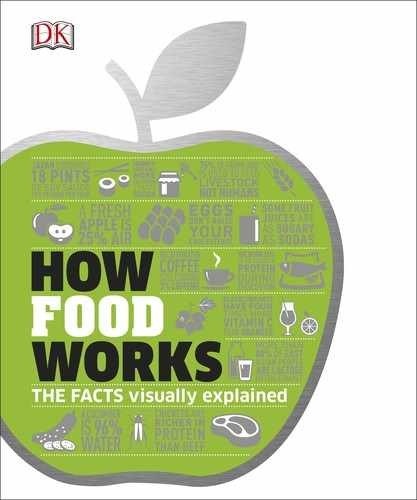
TYPES OF FOOD
Sweets
ROCK CANDY
Cotton candy is unusual in that it
is made by melting sugar without
dissolving it in water first. The
hot molten sugar is
sprayed through
a fine, spinning
nozzle. The force
creates long
strings, which cool
instantly into an
amorphous form,
producing this
fragile, melt-in-the-
mouth confection.
COTTON CANDY
Sweets
It may seem simple, but making sweets
is a delicate process. Carefully controlling
the temperature of a solution of sugar in
water produces a huge range of different
textures—from soft and chewy, to hard
and brittle. The addition of butter,
milk, or other ingredients expands
the possibilities.
Cooling slowly
Heating the solution to
a medium temperature
and then cooling it
very slowly around a
stick or string allows
large crystals to grow.
Cooling quickly
Heating the solution to a medium
temperature and then cooling it
rapidly does not allow crystals to
form. Instead, this produces the clear,
glassy appearance and hard, brittle
texture of lollipops and boiled candy.
Caramelization
At high temperatures, once all the water
has evaporated away, sugar caramelizes,
breaking down into a wide range of
darker and more flavorful molecules.
170
160
180
190
200
340
320
360
380
400
Large crystal of
glucose molecules forms
Glucose
KEY
Cooled
slowly
Cooled
quickly
Stirred while
cooling
Rapid cooling means
glucose molecules set far
away from each other
LOLLIPOPS
°C °F
Sugar breaks down
into different types
of molecules
C
R
È
M
E
C
A
R
A
M
E
L
US_146-147_Sweets.indd 146 23/02/2017 11:27
146 147
TYPES OF FOOD
Sweets
FUDGE
Adding butter and milk
The solution is heated to
a low temperature with
butter and milk, and then
stirred rapidly while it
cools, encouraging lots of
tiny crystals to form—the
smaller they are, the
smoother the fudge.
Adding gelatin
A marshmallow mix contains
gelatin (derived from animal
connective tissue, see p.72)—it
forms tangled chains that trap
air when the mixture is cooled
quickly and whipped. This
produces a light, fluffy texture.
Adding the “fizz”
Sherbet is made by mixing sugar and
flavorings with a powdered acid (giving
a sour flavor) and baking soda. Bubbles
of carbon dioxide in sherbet and popping
candy create the “fizz.”
Simple beginnings
Most candies are made simply by
heating water that has had sugar
dissolved in it. Different candies are
produced by controlling the water
content of the syrup, the maximum
temperature it is heated to, and the
speed of cooling and crystallization.
Adding ingredients can also affect
how crystals form, but adding butter
or milk also causes protein to react
with the sugar, initiating a browning
reaction similar to those that happen
in meat (see p.63)—this gives fudge
and caramels their flavor.
Making
popping candy
High-pressure carbon
dioxide is injected into pure
sugar syrup with all the water
boiled off. This forms bubbles
throughout the liquid.
Locked in
The mixture is
cooled rapidly—the sugar
has no time to crystallize
so it forms a disordered,
glasslike structure,
trapping the bubbles.
... and pop!
The warm moisture
of your tongue causes the
sugar to dissolve, releasing
the gas inside and the high-
pressure bubbles pop on
your tongue.
1
2
3
100
110
120
130
140
150
160
220
240
260
280
300
320
Glucose
Tangled
gelatin
chain traps
air bubble
Air
bubble
Small crystal of
glucose molecules forms
HEAT
MARSHMALLOWS
CHEWING GUMS
WERE MADE FROM
NATURAL TREE
GUMS, BUT MOST
ARE NOW MADE
SYNTHETICALLY
WATER AND
DISSOLVED SUGAR
Carbon
dioxide
US_146-147_Sweets.indd 147 23/02/2017 11:27

146 147
TYPES OF FOOD
Sweets
FUDGE
Adding butter and milk
The solution is heated to
a low temperature with
butter and milk, and then
stirred rapidly while it
cools, encouraging lots of
tiny crystals to form—the
smaller they are, the
smoother the fudge.
Adding gelatin
A marshmallow mix contains
gelatin (derived from animal
connective tissue, see p.72)—it
forms tangled chains that trap
air when the mixture is cooled
quickly and whipped. This
produces a light, fluffy texture.
Adding the “fizz”
Sherbet is made by mixing sugar and
flavorings with a powdered acid (giving
a sour flavor) and baking soda. Bubbles
of carbon dioxide in sherbet and popping
candy create the “fizz.”
Simple beginnings
Most candies are made simply by
heating water that has had sugar
dissolved in it. Different candies are
produced by controlling the water
content of the syrup, the maximum
temperature it is heated to, and the
speed of cooling and crystallization.
Adding ingredients can also affect
how crystals form, but adding butter
or milk also causes protein to react
with the sugar, initiating a browning
reaction similar to those that happen
in meat (see p.63)—this gives fudge
and caramels their flavor.
Making
popping candy
High-pressure carbon
dioxide is injected into pure
sugar syrup with all the water
boiled off. This forms bubbles
throughout the liquid.
Locked in
The mixture is
cooled rapidly—the sugar
has no time to crystallize
so it forms a disordered,
glasslike structure,
trapping the bubbles.
... and pop!
The warm moisture
of your tongue causes the
sugar to dissolve, releasing
the gas inside and the high-
pressure bubbles pop on
your tongue.
1
2
3
100
110
120
130
140
150
160
220
240
260
280
300
320
Glucose
Tangled
gelatin
chain traps
air bubble
Air
bubble
Small crystal of
glucose molecules forms
HEAT
MARSHMALLOWS
CHEWING GUMS
WERE MADE FROM
NATURAL TREE
GUMS, BUT MOST
ARE NOW MADE
SYNTHETICALLY
WATER AND
DISSOLVED SUGAR
Carbon
dioxide
US_146-147_Sweets.indd 147 23/02/2017 11:27
..................Content has been hidden....................
You can't read the all page of ebook, please click here login for view all page.
